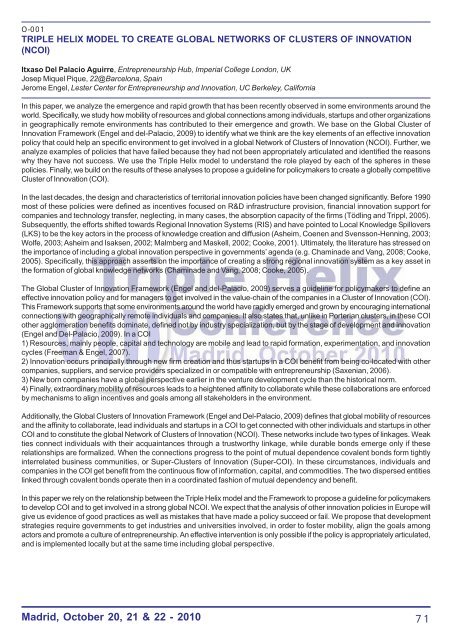TRIPLE HELIX noms.pmd
TRIPLE HELIX noms.pmd
TRIPLE HELIX noms.pmd
Create successful ePaper yourself
Turn your PDF publications into a flip-book with our unique Google optimized e-Paper software.
O-001<strong>TRIPLE</strong> <strong>HELIX</strong> MODEL TO CREATE GLOBAL NETWORKS OF CLUSTERS OF INNOVATION(NCOI)Itxaso Del Palacio Aguirre, Entrepreneurship Hub, Imperial College London, UKJosep Miquel Pique, 22@Barcelona, SpainJerome Engel, Lester Center for Entrepreneurship and Innovation, UC Berkeley, CaliforniaIn this paper, we analyze the emergence and rapid growth that has been recently observed in some environments around theworld. Specifically, we study how mobility of resources and global connections among individuals, startups and other organizationsin geographically remote environments has contributed to their emergence and growth. We base on the Global Cluster ofInnovation Framework (Engel and del-Palacio, 2009) to identify what we think are the key elements of an effective innovationpolicy that could help an specific environment to get involved in a global Network of Clusters of Innovation (NCOI). Further, weanalyze examples of policies that have failed because they had not been appropriately articulated and identified the reasonswhy they have not success. We use the Triple Helix model to understand the role played by each of the spheres in thesepolicies. Finally, we build on the results of these analyses to propose a guideline for policymakers to create a globally competitiveCluster of Innovation (COI).In the last decades, the design and characteristics of territorial innovation policies have been changed significantly. Before 1990most of these policies were defined as incentives focused on R&D infrastructure provision, financial innovation support forcompanies and technology transfer, neglecting, in many cases, the absorption capacity of the firms (Tödling and Trippl, 2005).Subsequently, the efforts shifted towards Regional Innovation Systems (RIS) and have pointed to Local Knowledge Spillovers(LKS) to be the key actors in the process of knowledge creation and diffusion (Asheim, Coenen and Svensson-Henning, 2003;Wolfe, 2003; Asheim and Isaksen, 2002; Malmberg and Maskell, 2002; Cooke, 2001). Ultimately, the literature has stressed onthe importance of including a global innovation perspective in governments’ agenda (e.g. Chaminade and Vang, 2008; Cooke,2005). Specifically, this approach asserts on the importance of creating a strong regional innovation system as a key asset inthe formation of global knowledge networks (Chaminade and Vang, 2008; Cooke, 2005).The Global Cluster of Innovation Framework (Engel and del-Palacio, 2009) serves a guideline for policymakers to define aneffective innovation policy and for managers to get involved in the value-chain of the companies in a Cluster of Innovation (COI).This Framework supports that some environments around the world have rapidly emerged and grown by encouraging internationalconnections with geographically remote individuals and companies. It also states that, unlike in Porterian clusters, in these COIother agglomeration benefits dominate, defined not by industry specialization, but by the stage of development and innovation(Engel and Del-Palacio, 2009). In a COI1) Resources, mainly people, capital and technology are mobile and lead to rapid formation, experimentation, and innovationcycles (Freeman & Engel, 2007).2) Innovation occurs principally through new firm creation and thus startups in a COI benefit from being co-located with othercompanies, suppliers, and service providers specialized in or compatible with entrepreneurship (Saxenian, 2006).3) New born companies have a global perspective earlier in the venture development cycle than the historical norm.4) Finally, extraordinary mobility of resources leads to a heightened affinity to collaborate while these collaborations are enforcedby mechanisms to align incentives and goals among all stakeholders in the environment.Additionally, the Global Clusters of Innovation Framework (Engel and Del-Palacio, 2009) defines that global mobility of resourcesand the affinity to collaborate, lead individuals and startups in a COI to get connected with other individuals and startups in otherCOI and to constitute the global Network of Clusters of Innovation (NCOI). These networks include two types of linkages. Weakties connect individuals with their acquaintances through a trustworthy linkage, while durable bonds emerge only if theserelationships are formalized. When the connections progress to the point of mutual dependence covalent bonds form tightlyinterrelated business communities, or Super-Clusters of Innovation (Super-COI). In these circumstances, individuals andcompanies in the COI get benefit from the continuous flow of information, capital, and commodities. The two dispersed entitieslinked through covalent bonds operate then in a coordinated fashion of mutual dependency and benefit.In this paper we rely on the relationship between the Triple Helix model and the Framework to propose a guideline for policymakersto develop COI and to get involved in a strong global NCOI. We expect that the analysis of other innovation policies in Europe willgive us evidence of good practices as well as mistakes that have made a policy succeed or fail. We propose that developmentstrategies require governments to get industries and universities involved, in order to foster mobility, align the goals amongactors and promote a culture of entrepreneurship. An effective intervention is only possible if the policy is appropriately articulated,and is implemented locally but at the same time including global perspective.Madrid, October 20, 21 & 22 - 201071










